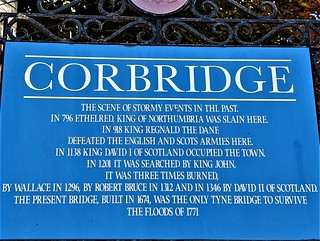Corbridge, England
Market Cross
This evening, I am reporting on the delightful market town of Corbridge (pop 3000) in northern England.
Location is about 42 miles east of Carlisle.
The name translates as 'Bridge near Corchester' with latter being derived from the old Roman town of Corstopitum nearby. Directly and indirectly the settlement at Corbridge can be traced back to AD79 when a Roman fort was established nearby. Over about 330 years the original Roman fort morphed into a civilian settlement which came to an end around AD410 when the Romans abandoned Britain.It seems the incoming Saxons established a new settlement about one mile to the east of the Roman town from which the current town has evolved.
This image shows the Roman town with modern town in distance.
A summary of Corbridge's history can be viewed in the image below.
Overview of Corbridge's post-Roman history
Overall, Corbridge impresses as an attractive and prosperous English market town with a wide variety of shops and interesting architecture.
Visitors can explore the locality on foot via fourteen local walking routes ranging from 1.5 to 10 miles.
A selection of images is provided below.
Colourful cottage garden near bridge over River Tyne.
View of River Tyne looking west
The Angel Inn dates back to 1569 and may rank as the oldest 'inn' in Northumberland.
Interesting architecture in Princes Street.
An unusual mixture of pagan and Christian manifestations.The old market cross which, mounted on a Roman altar from adjacent Corstopitum, stood for some 600 years in the market place until removed in 1807.
This is a defensive Pele House built for occupation by the local vicar (priest).
Because of the trouble between England and Scotland during the 14th-17th centuries the border area (in which Corbridge sits) was almost a battlefield and warfare was endemic between the two. The Border folk suffered terribly as a result. They began to pay no attention to the laws of the country, living by their own rules to ensure survival and banding themselves together in their families
Although the rest of England mostly enjoyed peace and prosperity by the sixteenth century, in the Border country raiders, or ‘reivers’ were still constantly crossing back and forth in the disputed border areas. Homes of high status people needed thick walls and tunnel-vaulted rooms to defend themselves and their livestock. This situation had continued for over three hundred years.
St.Andrew's Parish Church (Anglican).
This ancient, monastic church probably founded by St Wilfred almost over 1300 years ago. It is one of the most important surviving Saxon monuments in Northumbria except for Hexham crypt.
Here in the only substantial stone building in the centre of Corbridge, past residents were able to survive the burning and pillaging of their timber houses by the Danes who invaded before the Scots during border warfare which lasted over 300 years from 1296.
The church was built in approximately 674 as part of a monastery. It had a small porch at the west, a tall narrow nave and a small sanctuary. Light shone in from only 3 small windows set high in the roof.
In 919 the Danes invaded and the church was partially destroyed. The Normans came in the 11th century and they set about rebuilding the church. They raised the tower, building the north and south transepts and made the entrance on the southern side. It was an era of peace and stability.Corbridge flourished and grew making a very prosperous village.
Times changed with the border warfare of William Wallace in 1296 and the Black Death in 1349.
St Andrew’s lay in ruins until 1767 when a prosperous Corbridge inhabitant paid for a workhouse, village pant and the original church clock. It only had the hour hand, getting its minute hand in 1861, progress!
The Victorian era saw new windows, bells, a beautiful new porch and our unique war memorial lychgate.
Church interior
Local shop
Landscape south of Corbridge with River Tyne in centre.
This is the pavement of the King's Oven, a communal facility for the baking of the villagers' bread and meat. It was first recorded in 1310 and continued in use until the 19th century.
Blue Bell Pub
This town, together with adjacent Roman site, provides the visitor with the opportunity to connect with nearly 2000 years of English history.
P.S. Apologies for quality of images.My main camera suffered a malfunction forcing me to resort to cellphone.
















Comments
Post a Comment